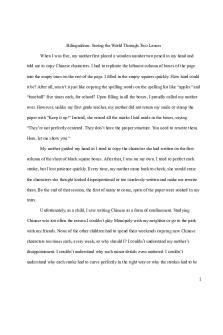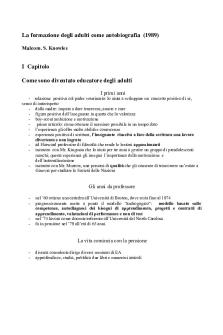ENGL 101 literacy narrative of Malcom X\'s Learning to read PDF

| Title | ENGL 101 literacy narrative of Malcom X\'s Learning to read |
|---|---|
| Course | Critical Reading and Composition |
| Institution | University of South Carolina |
| Pages | 2 |
| File Size | 45.8 KB |
| File Type | |
| Total Downloads | 87 |
| Total Views | 148 |
Summary
This is an analysis of Malcom X's "Learning to Read" and its relation to a literacy narrative....
Description
A literacy narrative could also be considered a type of autobiography, which contains a personal story of one's life events. This is conveyed through language and writing. However, these personal stories are not written like a personal journal, but rather an open and public description of one's life. In today's world, people think autobiographies are mainly about celebrities, politicians, or any famous person, but anyone can write and share an autobiography. College essays can be considered autobiographies because most of the time they describe personal stories or memories. Other examples may include describing childhood memories or composing class essays based off of personal experiences. When comparing autobiographies and literacy narratives, literacy narratives reflect on reading, writing, and language. Literacy narratives still use personal stories and memories and may persuade a reader to communicate their own personal stories with reading, writing, and language. The subject of a literacy narrative should be significant events or memories and express feelings and emotions through text. Not only can one write about an event, but another person as well. In Malcom X's "Learning to Read", he conveys emotions and the journey of creating his own education. This fits into the genre of literacy narrative because he explains the process of how he taught himself to read and write and says, "I became increasingly frustrated at not being able to express what I wanted to convey in the letters that I wrote" (340). In this text, he openly expresses his emotions through his writing, which is an important part of a literacy narrative. Malcom explained his wishes of being able to thoroughly read and write, and overall have his own education like the people around him had. He says, "It had really begun back in the Charlestown Prison, when Bimbi first made me feel envy of his stock of knowledge" (340). This again explains another emotion, envy, and begins at the beginning of his journey that he is about to share. He then continues to share the next steps in his journey, which included getting a dictionary to help
him learn words and at least start somewhere. He would copy words and write them down, say them out loud, and continue to repeat them over and over again until he was satisfied. He then shares his next emotion with the readers by saying, "I woke up the next morning, thinking about those words - immensely proud...Moreover, with a little effort, I also could remember what many of these words meant" (341). He explains his feelings of accomplishment and success, and is impressed with his own learning speed. Throughout his journey, he realized that he was mainly interested in African culture and how different African Americans were treated than white people. However, he didn't focus on just one topic and attempted to learn as much as he possibly could. Towards the end of his story he says, "As I see it today, the ability to read awoke inside me some dormant craving to be mentally alive" (346). Through the struggles of teaching himself to read and write, he finally feels a sense of happiness that he had been longing for his whole life. His story starts as a desperate young man craving the education everyone else had, and ends with an incredible and impressive accomplishment of giving himself his own education. After reading "Learning to Read", it is clear that this is a literacy narrative because it not only explains Malcom X's personal journey with reading and writing, but also conveys strong emotions through his words and allows the reader to feel how he once felt....
Similar Free PDFs

Literacy Narrative
- 5 Pages

Sample Literacy Narrative
- 5 Pages

Literacy Narrative - Grade: n/a
- 5 Pages

ENGL 101 Blackbird analysis
- 2 Pages

Engl 101 educational argument
- 1 Pages

Learning to read by Malcolm X
- 6 Pages

ENGL 101 My Father\'s English
- 2 Pages

Formazione adulti malcom knowles
- 9 Pages

HOW TO READ Ethnography
- 2 Pages
Popular Institutions
- Tinajero National High School - Annex
- Politeknik Caltex Riau
- Yokohama City University
- SGT University
- University of Al-Qadisiyah
- Divine Word College of Vigan
- Techniek College Rotterdam
- Universidade de Santiago
- Universiti Teknologi MARA Cawangan Johor Kampus Pasir Gudang
- Poltekkes Kemenkes Yogyakarta
- Baguio City National High School
- Colegio san marcos
- preparatoria uno
- Centro de Bachillerato Tecnológico Industrial y de Servicios No. 107
- Dalian Maritime University
- Quang Trung Secondary School
- Colegio Tecnológico en Informática
- Corporación Regional de Educación Superior
- Grupo CEDVA
- Dar Al Uloom University
- Centro de Estudios Preuniversitarios de la Universidad Nacional de Ingeniería
- 上智大学
- Aakash International School, Nuna Majara
- San Felipe Neri Catholic School
- Kang Chiao International School - New Taipei City
- Misamis Occidental National High School
- Institución Educativa Escuela Normal Juan Ladrilleros
- Kolehiyo ng Pantukan
- Batanes State College
- Instituto Continental
- Sekolah Menengah Kejuruan Kesehatan Kaltara (Tarakan)
- Colegio de La Inmaculada Concepcion - Cebu






